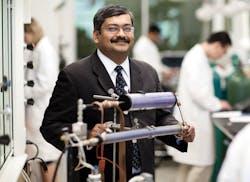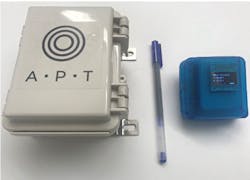Aerosol Monitoring Technology Takes “Airborne Precautions"
Scientists are urgently looking at the different environmental conditions in which COVID-19 can persist.
Specific tests include looking at how humidity, temperature and ultraviolet light affect the disease, how long it lives on different surfaces, as well as the way the COVID-19 compares to SARS and MERS, or the common cold viruses currently in circulation. The World Health Organization (WHO) and other health officials use this information to make sure their guidance is appropriate.
COVID-19 is transmitted through droplets of liquid that come out of people’s noses and mouths if they cough, sneeze or talk, said Dr. Maria Van Kerkhove, an infectious disease epidemiologist and technical consultant for the WHO. “What is known about droplet transmission is that when they come out of an infected person, the droplets go a certain distance but then settle,” she said during a press briefing, adding that it is the reason for the recommendation to keep a distance of one to two meters (three to six feet) apart from individuals.
“But when you do an aerosol-generating procedure in a medical care facility, you have the possibility to what we call aerosolize these particles, which means they can stay in the air a little bit longer,” explained Van Kerkhove. “In that situation, in healthcare facilities, it’s very important that healthcare workers take additional precautions when they’re working on patients and doing those procedures.”
Severe acute respiratory syndrome coronavirus 2 (SARS-CoV-2)—which is the virus that causes coronavirus disease—was detectable in aerosols for up to three hours, up to four hours on copper, up to 24 hours on cardboard, and up to two to three days on plastic and stainless steel, according to the National Institutes of Health.
Building on this critical part of understanding the virus, scientists at the Aerosol and Air Quality Research Laboratory (AAQRL) at the McKelvey School of Engineering at Washington University in St. Louis are currently in discussions with the School of Medicine to deploy aerosol monitoring equipment and sensors for real-time, remote monitoring for SARS-CoV-2 in enclosures where patients will be tested.
The work is part of a battery of studies across the globe looking at the different environmental conditions in which COVID-19 can persist, said Dr. Pratim Biswas, president of the International Aerosol Research Assembly and head of the AAQRL team.
“We have to step up and work with our colleagues in the medical sciences, and work as a team to help overcome the crisis,” said Biswas, whose research accomplishments earned him the 2018 Fuchs Award, the highest honor given to aerosol scientists. “As the coronavirus encountered now is rather new and novel, and as sufficient studies are just being conducted, we need to use best practices and findings from other studies with a strong scientific underpinning, to develop guidelines and approaches with COVID-19. Guidance to frontline healthcare workers is important at this stage.”
Machine Design talked to Biswas about his work in novel, real-time measurement techniques for measuring viral particles in air.
Q. As head of the AAQRL at the McKelvey School of Engineering at Washington University, what is your research focus?
My research focus is in aerosol science and engineering—the fundamentals associated with particle formation, growth and transport. Aerosol science and engineering is an enabling discipline with applications to the environment, energy, advanced materials, medicine and health. Details of my research project and research group are available at aerosols.eece.wustl.edu.
Q. Tell us about the aerosol monitoring equipment. Please describe the design of the equipment as well as summarize the modelling tools you use in this application.
There are a range of real-time instruments that can be used to measure small particles of sizes close to viruses. There are a range of electrical mobility analyzers which can accurately measure particles in the range of 1 nm to 1000 nm in real time. There are also optical particle counters which can measure in the range of 300 nm and up.
Q. What are the sensors’ function in achieving real-time, remote monitoring?
Our current sensors have been miniaturized and marketed by a startup company called Applied Particle Technology. They are optical-based units and have a dashboard set up to monitor the particulate matter (PM) concentrations in real time. Using IoT concepts we can operate them remotely. We have fixed versions (image below, left) of these monitors and wearable versions (right). We are currently deploying them for use in the Barnes Jewish Hospital for measurement in chambers where COVID-19 patients will be checked by physicians. Our collaborators are from the Infectious Disease program, School of Medicine, Washington University in St. Louis.
Q. What are the ideal applications, and how can it be useful for testing patients with SARS-CoV-2 in enclosures?
Ideally, we would use a more specific device designed for measurement of viruses. These devices have a very high efficiency of collection for the viral nanoparticles and then can follow up by real-time polymerase chain reaction (RT-PCR) techniques for specificity of the type of virus.
In the current work, we are deploying the more robust PM sensors to get an idea of the contamination in the room. If the patients are coughing or sneezing, the particles are in the size range of the devices deployed, and will provide information in real time on the level of cleanliness in the room. This is essential to ensure that the healthcare workers are protected.
Q. You have a patent on technology described as combining “photoionization with electrostatic precipitation that has been proven to be highly effective at capturing viruses and other bioagents.” Can you elaborate on the innovation and its function?
The U.S. patented device (US Patent 6,861,036) is a photoionizer enhanced electrostatic precipitator for air cleaning. It works on the principle of charging the virus or bacteria, and then trapping them in an electric field. In the process, the virus or bacteria is completely inactivated (it cannot infect any human or living organism). The device has a very high efficiency of capture and has been demonstrated to destroy all biological agents such as viruses. Furthermore, the exhaust air has no byproducts, and has very low levels of ozone. The innovation of combining the two mechanisms of photoionization with electrostatic coronas suppresses ozone formation, but ensures high capture and inactivation efficiency.
Q. Tell us about your ultimate objectives based on your techniques in the controlled studies for measuring viral particles in air. What have you learnt up until now, and where is the research leading your team?
We have done several studies on the measurement of viruses in real time using innovative aerosol methodologies. With some pre-knowledge of the viral nanoparticle, we have been able to rapidly determine the presence of these agents in air.
Current studies are focused on establishing the transport and transmission characteristics of coronaviruses. This will be useful in determining how far the virus is transported, and potentially how and where it deposits in the respiratory tract. This is also going to be useful in predicting the infectivity to humans—such as that happening due to community spread of the coronavirus.
Q. What is one noteworthy takeaway that you offer multi-disciplinary engineers and researchers currently working in this area of research?
Work together to tackle the problem. Such a complex problem requires a true “team science” effort to promote a fundamental understanding that will help understand and solve the issues we face.
About the Author

Rehana Begg
Editor-in-Chief, Machine Design
As Machine Design’s content lead, Rehana Begg is tasked with elevating the voice of the design and multi-disciplinary engineer in the face of digital transformation and engineering innovation. Begg has more than 24 years of editorial experience and has spent the past decade in the trenches of industrial manufacturing, focusing on new technologies, manufacturing innovation and business. Her B2B career has taken her from corporate boardrooms to plant floors and underground mining stopes, covering everything from automation & IIoT, robotics, mechanical design and additive manufacturing to plant operations, maintenance, reliability and continuous improvement. Begg holds an MBA, a Master of Journalism degree, and a BA (Hons.) in Political Science. She is committed to lifelong learning and feeds her passion for innovation in publishing, transparent science and clear communication by attending relevant conferences and seminars/workshops.
Follow Rehana Begg via the following social media handles:
X: @rehanabegg
LinkedIn: @rehanabegg and @MachineDesign



